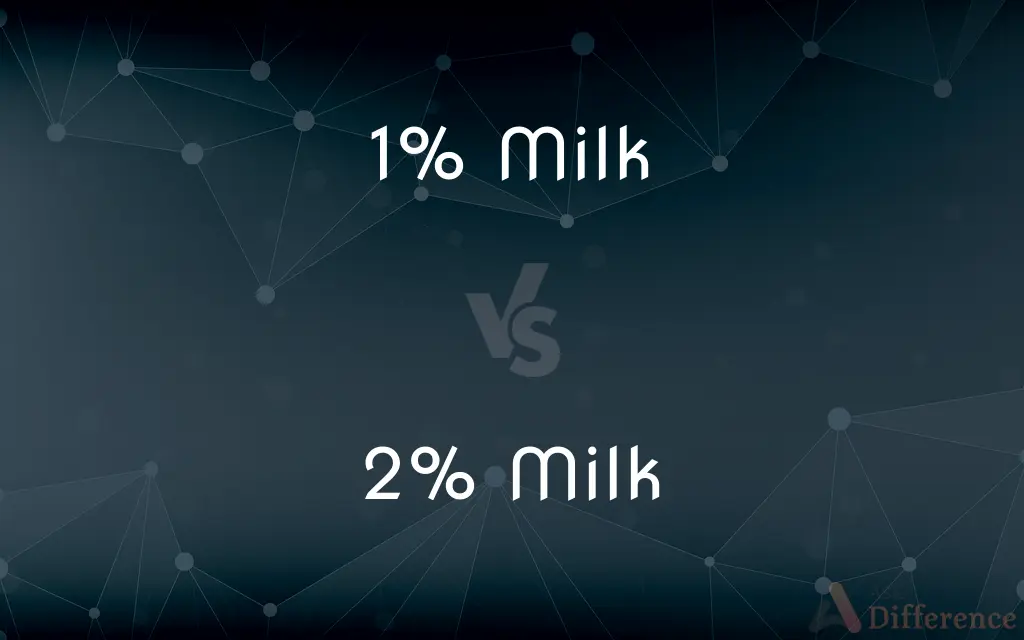1% Milk vs. 2% Milk — What's the Difference?
By Tayyaba Rehman — Published on January 29, 2024
1% milk has 1% milkfat by weight, offering a lighter option with fewer calories, while 2% milk contains 2% milkfat, providing a creamier taste with more calories.

Difference Between 1% Milk and 2% Milk
Table of Contents
ADVERTISEMENT
Key Differences
1% milk, also known as low-fat milk, contains 1% milkfat by weight, making it a lower calorie and lower fat option than whole milk. 2% milk, often called reduced-fat milk, has 2% milkfat, offering a balance between whole milk and skim milk in terms of creaminess and fat content.
The main difference in nutritional content between 1% and 2% milk lies in their fat content; 1% milk has less total fat, saturated fat, and cholesterol. In contrast, 2% milk has slightly higher levels of these components, making it creamier and richer in flavor.
Both 1% and 2% milk are fortified with vitamin A and D, but the lower fat content in 1% milk means it has fewer calories compared to 2% milk. This makes 1% milk a preferable choice for those monitoring their calorie intake.
In culinary uses, 1% milk is often used in recipes where lower fat content is desired, such as in cereals, coffee, and smoothies. 2% milk is preferred in recipes that require a balance of creaminess without the full fat of whole milk, like in sauces and baked goods.
Taste-wise, 1% milk is less creamy and has a thinner consistency than 2% milk, which has a more pronounced milk flavor and creamier texture. The choice between the two often comes down to personal preference regarding taste and dietary needs.
ADVERTISEMENT
Comparison Chart
Milkfat Content
1% milkfat by weight
2% milkfat by weight
Calories
Lower
Higher
Creaminess
Less creamy, thinner consistency
Creamier, richer texture
Nutritional Content
Lower in fat, saturated fat, and cholesterol
Slightly higher in fat and calories
Culinary Use
Suitable for lighter recipes and beverages
Preferred for a balance of flavor and texture
Compare with Definitions
1% Milk
Low-fat milk with 1% milkfat.
He poured 1% milk into his coffee.
2% Milk
Reduced-fat milk with 2% milkfat.
He prefers 2% milk for its creaminess.
1% Milk
Suitable for cereals and light beverages.
They used 1% milk in their morning smoothies.
2% Milk
Good for sauces and baking.
The recipe called for 2% milk to enhance the dessert's richness.
1% Milk
Has less saturated fat and cholesterol.
1% milk is a great option for heart-healthy diets.
2% Milk
Contains more calories and fat than 1% milk.
2% milk adds a rich flavor to his tea.
1% Milk
Contains fewer calories than whole milk.
She switched to 1% milk for a healthier diet.
2% Milk
Creamier than 1% milk, but less than whole milk.
2% milk is her favorite compromise between taste and health.
1% Milk
Often fortified with vitamins A and D.
The 1% milk bottle boasted added vitamins for nutrition.
2% Milk
Popular choice for balanced diet.
Their household chooses 2% milk for its nutritional balance.
Common Curiosities
Can I use 2% milk for baking?
Yes, it's great for baking, offering richness without too much fat.
Does 1% milk taste different from whole milk?
Yes, it's less creamy and has a thinner consistency.
How much fat is in 2% milk?
It contains 2% milkfat by weight.
Is 2% milk good in coffee?
Yes, it adds creaminess without being too heavy.
Is 2% milk lower in cholesterol than whole milk?
Yes, it has less cholesterol than whole milk.
What is 1% milk?
It's low-fat milk with 1% milkfat by weight.
Is 1% milk fortified with vitamins?
Yes, it's often fortified with vitamins A and D.
Is 1% milk healthier than 2% milk?
It has fewer calories and less fat, making it a lower-calorie option.
Can I substitute 1% milk for whole milk in recipes?
Yes, but it will reduce the creaminess and richness.
Does 2% milk have more calories than 1% milk?
Yes, due to its higher fat content.
Can lactose-intolerant people consume 1% milk?
They might still have issues, as it contains lactose.
Is 2% milk better for children than 1% milk?
It depends on dietary needs and preferences.
Is 2% milk a good source of calcium?
Yes, like all dairy milk, it's a good calcium source.
Can I use 1% milk in smoothies?
Absolutely, it's great for lighter smoothies.
Are 1% and 2% milk both available in organic forms?
Yes, most dairies offer organic versions of both.
Share Your Discovery

Previous Comparison
Bell of Stethoscope vs. Diaphragm of Stethoscope
Next Comparison
Partial Highlights vs. Full HighlightsAuthor Spotlight
Written by
Tayyaba RehmanTayyaba Rehman is a distinguished writer, currently serving as a primary contributor to askdifference.com. As a researcher in semantics and etymology, Tayyaba's passion for the complexity of languages and their distinctions has found a perfect home on the platform. Tayyaba delves into the intricacies of language, distinguishing between commonly confused words and phrases, thereby providing clarity for readers worldwide.













































